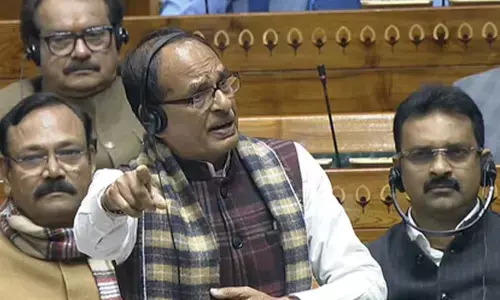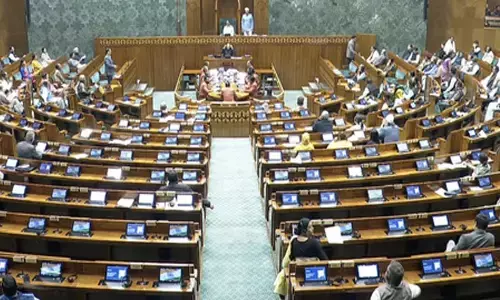Saffronisation of the mandal

The vicious cycle of political discourse in the country has come a full circle. The fight between the so-called secular and Hindutva forces has seen the emergence of the Rashtriya Swayam Sevak Sangh as a superior force, politically.
The vicious cycle of political discourse in the country has come a full circle. The fight between the so-called secular and Hindutva forces has seen the emergence of the Rashtriya Swayam Sevak Sangh as a superior force, politically.
The debate also could be called a Mandal vs Kamandal one. The RSS which is in full control of the BJP has deftly played its cards to install its very own in the top three positions of the country – the Presidential Office, the Vice-Presidential office and that of the Prime Minister's. We could even add the Speaker's office to the list (Sumitra Mahajan is also an RSS ideologue).
There is Ram Nath Kovind as the President and Supreme Commander of the Armed Forces of the country and then we have M Venkaiah Naidu, as the Vice-President of the country and, lastly, Narendra Damodar Modi as the Prime Minister of the country – all the three from the RSS background.
All the three are hardcore Sanghis and are proud to admit it. They owe their positions to the organisation that has imparted its training and ingrained its pedagogy into them. The trusted lieutenants have not let down their alma mater as they were allowed to gain in stature and occupy prime positions having their services transferred to the BJP.
Look at Muppavarapu Venkaiah Naidu who will be our next Vice-President in a couple of weeks. The most important role of the Vice-President is being the Chairman of the Rajya Sabha which calls for vast experience in political, legislative and administrative matters. Of course, Venkaiah Naidu has all these aplenty, but what is more important is his RSS indoctrination. Naidu joined the RSS during his college days and played an active role in the college unions as a student leader.
The President, Ram Nath Kovind, is also from the RSS-BJP school. His being Dalit may not really benefit the BJP in terms of votes, but it certainly adds value to its arguments that it is party of dalits, mahadalits, OBCs, tribals and Most Backward Classes and believes in social justice. Ram Nath Kovind has become the President elect not because of this social justice factor alone, but more importantly he has become so because of his RSS-BJP background.
The BJP leadership could call this mandalisation of the party. But the truth – that these are all with RSS background – must not be lost track of.
Let us turn our attention to the present residents of the Raj Bhavans in the country. Governors of 14 States have the RSS background. Take for example the case of Nagaland. Padmanabha Acharya is of the RSS background and he was a leader of Akhil Bharatiya Vidyarthi Parishad too. (He is in-charge of Arunachal Pradesh moreover now).
West Bengal Governor Keshari Nath Tripathi is a Sanghi to the core having joined the RSS at the age of 12 itself. He has been a Swayam Sevak ever since. Uttar Pradesh Governor Ram Naik too has been a Swayam Sevak since his childhood. Dr Tathagat Roy, a distinguished engineer and professor, joined the RSS in 1986 while in service and quit the service in 1990 to join the BJP.
He is now the Governor of Tripura. Channamaneni Vidyasagar Rao, the present Governor of Maharashtra, too has RSS-BJP background just as Rajasthan's Kalyan Singh and Karnataka's Vajubhai Vala.
Himachal Predesh's Acharya Dev Vrat is associated with the RSS programmes though he is from the Arya Samaj and Haryana's Kaptan Singh Solanki too is a Governor with RSS background. Gujarat's Omprakash Kohli and Goa's Mridula Sinha have all been associated with the RSS just as Chattisgarh's Balram Das Tandon. The latter was a RSS pracharak.
Let us not here mention the heads of various organisations and institutions who have a similar background and have come to occupy high positions in the country. No one can question the appointments as these are all political moves. Congress did the same while in power filling up all vacancies with "secular forces" (read pro-Congress or anti-BJP and anti-RSS).
In fact, Mamata Benerjee has done the most ridiculous thing that one could ever imagine in appointing her State's Urban Development Minister Firhad Hakim as the Chairman of the Tarakeshwar Development Board (TDB) in Hooghly district. As usual, none from the Congress or the Left questioned the appointment. May be that is a secular move for Mamata. But, she would have been more justified if she were to appoint Hindus or Christians to Muslim Shrines or Wakf Boards.
Remember the move of Akhilesh Yadav: He appointed Azam Khan as the 'prabhari' of Kumbh Mela.
Does this mean that the BJP-RSS tango is bound to continue uninterrupted for a long time to come?
The present BJP strength lies in this RSS bond more than any. The national president of the BJP, Amit Shah, also is a Sanghi.
He joined the Rashtriya Swayamsevak Sangh at the age of 14. He used to attend the local shakhas (branches) of the RSS and became a volunteer for the RSS in his college days itself. Amit Shah met Narendra Modi, an RSS pracharak, for the first time in 1982. During this period Amit Shah became the secretary of the RSS student body, Akhil Bharatiya Vidyarthi Parishad (ABVP). Amit Shah also became an activist of the BJP's youth wing, Bharatiya Janata Yuva Morcha (BJYM).
Amit Shah and Narendra Modi together destroyed the Congress in Gujarat's rural areas in the 1990s. The combo continues to this day. Together they changed the political narrative completely. The duo chose Ram Nath Kovind for the top post of the country shrewdly, a move that took the wind out of the sails of the Opposition and the huge majority he secured over the Congress candidate, Meira Kumar – wherein even Nitish Kumar and Mulayam Singh Yadav voted for the NDA candidate – is proof enough of the winnability of the Shah-Modi combination.
This is for the first time ever that top three political posts in the country have gone to the RSS-background leaders in the country. Not once did this happen in the last seven decades with Atal Bihari Vajpayee being the only exception when he became the head of a coalition government in 1998.
The way the push was undertaken by the RSS-BJP leadership is brilliant. In the Presidential election the other day, many in the Opposition voted for Ram Nath Kovind and not for Meira Kumar. In Gujarat, a key State which is already in an election mode and which is voting for three Rajya Sabha seats on August 8 including that of the one held by veteran Congress leader, Ahmed Patel, who is a quintessential courtyard usher captain of 10 Janpath, 11 Congress MLAs reportedly voted for Kovind. Two AAP MPs in Punjab voted for the NDA nominee and in West Bengal the NDA secured five votes more than its strength of six.
In Tripura too, Ram Nath secured seven votes as the TMC legislators there revolted while in Maharashtra too Meira Kumar got at least 10 votes less than the expected 87. Goa saw three additional votes being polled for Ram Nath and in UP, eight non-NDA legislators voted for him.
The Opposition is failing miserably in retaining its vote bank. It also does not seem to understand that the RSS-BJP combine is redefining the political contours by deftly handpicking 'right choices' to project it as mandalisation of kamandal, while, in fact, it is the other way round – saffronisation of the mandal.

















